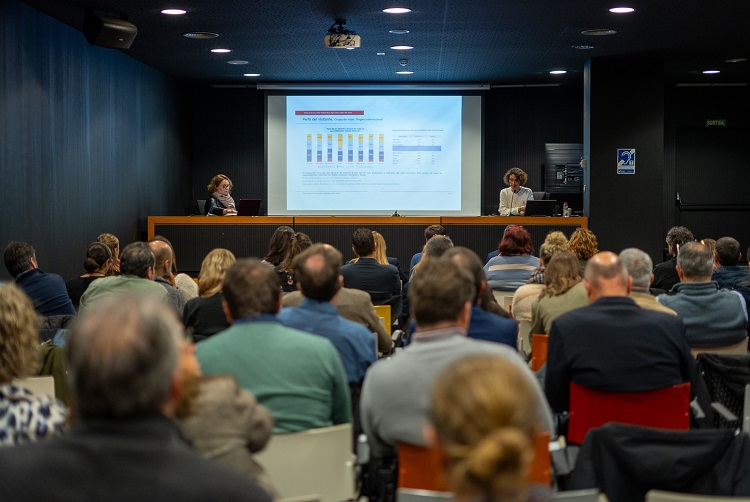The good perception of tourist safety, with 95 points out of 100, and the significant difference in customer satisfaction scores between refurbished and non-refurbished hotels of the same category, are two of the main conclusions that were presented at the presentation organised by Lloret Turisme, together with Mabrian Technologies, to present the report on tourism data for the summer season (May-October) in Lloret de Mar, extracted from the destination’s tourism intelligence and big data tool and attended by around fifty professionals from the tourism sector.
This platform is fed by different sources such as: scheduled air capacity, flight prices, card spending at the destination, comments on social networks, searches on Google’s metasearch engine, profiles and behaviour of visitors who have booked through Booking.com and complementary sources such as the data on tourists and overnight stays provided monthly by the National Statistics Institute (INE). For the Mayor of Lloret de Mar, Adrià Lamelas, “The conclusions show, on the one hand, that we still have the potential to strengthen the pre- and post-season months because there is a general interest in the destination from both the domestic and international markets and, on the other, that there is room for improvement to achieve a better balance between the needs of tourists and residents in July and August”.
The number of visitors and overnight stays in hotels estimated by the INE for this summer season (May-October) closed with 943,537 visitors and 4,320,547 overnight stays compared to 889,448 travellers and 3,957,980 overnight stays in 2023 for the same period.
In the words of Elizabeth Keegan, manager of Lloret Turisme, “Updated hotels improve customer satisfaction and price and are an important ally in the repositioning and diversification strategy of the destination”.
MAIN CONCLUSIONS
Increased interest in Lloret de Mar on the part of international markets and a decline in local markets during the central summer months, returning to a ratio of national to international travellers very similar to the pre-pandemic:
- +6% visitors and +9% overnight stays compared to the previous year.
- The French market is losing presence, but remains by far the leading international market.
- The UK and Germany became the main source markets in June and July respectively.
- An increase in overnight stays is observed in all months, especially from May to July.
The average length of stay was 4.6 days, a slight increase on the previous year.
Increased air connectivity at Girona and Barcelona airports
- Girona Airport: The British market continues to have the greatest weight in arrivals by air with Jet2, TUI and Ryanair. Ireland, with 4 connections, has more than doubled its air capacity with Ryanair in Girona compared to 2019.
- The German market, also with Ryanair and 6 connections this 2024, has grown substantially compared to 2023, as has Poland.
Customer segment
- Holidays with friends gain weight compared to other travel groups, especially families, in the Italian, Dutch and Swiss markets, especially in July and August.
Average card spending grows significantly
- Average spend at destination increased in almost all markets (+2%), with the exception of Germany.
- Decrease in the weight of expenditure on accommodation in relation to restaurants, bars and nightclubs.
Higher occupancy and slightly improved ADR in hotel accommodation
- Hotel occupancy levels increase in all months of the summer season, with August above 90%.
- The average length of stay has increased slightly in all months except August.
- The ADR in July has increased slightly to €120 and in August to €134.
- The difference in prices of the updated 4* hotels is 10% higher than the rest.
Hotel satisfaction and prices
- Upgraded 4-star hotels far outperform the rest in customer satisfaction.
- The satisfaction index of these establishments stands at 77 out of 100, while that of the rest stands at 44 out of 100.
- According to data published in OTAs, the updated establishments work with 10% higher prices.
- The overall index of customer satisfaction with the destination is 87 points, of which 68 points are for satisfaction with the tourism product, 95 points for the safety index and 92 points for the climate index.
CONCLUSIONS BY MARKET
Domestic market
Lloret de Mar continues to retain part of the national public that has rediscovered the destination during the pandemic.
Early summer (May, June) and late summer (September, October) getaways are key to retaining this audience.
France
It reduces its weight especially in the central summer months.
4% increase in average expenditure, with accommodation being the main category of expenditure, followed by food, indicating that holiday homes and flats are gaining in popularity.
As a public profile, an important weight of couples and families, especially in the months of May and June.
United Kingdom
The United Kingdom became the second largest international outbound market, with an 11% increase in overnight stays compared to the previous year.
The interest of the British market is growing, especially in the months of May, June and September, with a higher proportion of single travellers and an average stay of 5.5 days.
Germany
Strong growth of interest in all summer months, with June, July and August being the most important months. The large increase in air capacity and the reduction in the price of airline tickets has favoured this growth.
The Netherlands
Growing interest with respect to 2023, very focused on July, which translates into an increase in overnight stays, especially in this month.
Switzerland
Second market with the second highest average expenditure at destination. Accommodation is the main expenditure.
Belgium
A loyal market with a balanced customer profile and one of the longest average stays.
Poland
It maintains its presence, especially because of its family profile.
The market with the longest average stay of all the markets analysed.
Italy
Growth of 8% in overnight stays compared to the previous year.
The group of friends is the predominant segment, with a greater presence of women.
Ireland
Great increase in interest in Lloret de Mar, with an increase of 14% in overnight stays compared to the same period last year, especially in May, with a growth of 108%. Spending at the destination is the highest.
Nordic countries
Interest is growing in all the Nordic countries, although the lack of connectivity makes it more difficult to translate this into overnight stays.






